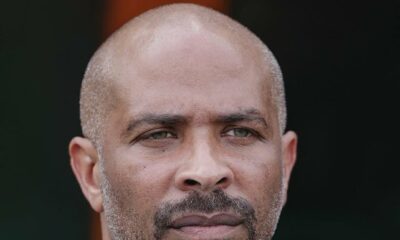News
Idris Adekojo: The World Cup & Tactics
 The FIFA World cup is always a good measure of the best style of football in a particular era. Different prevailing styles have emanated from different FIFA World cups, back in The 60’s club football games were amazingly physical and aggressive and it reflected on the way teams line up to play in the summer world cup. In the 70’s however things had become more cultured and technical and we all saw Spain’s Midfield pressing style ultimately prevailing in South Africa.
The FIFA World cup is always a good measure of the best style of football in a particular era. Different prevailing styles have emanated from different FIFA World cups, back in The 60’s club football games were amazingly physical and aggressive and it reflected on the way teams line up to play in the summer world cup. In the 70’s however things had become more cultured and technical and we all saw Spain’s Midfield pressing style ultimately prevailing in South Africa.
2014 In Brazil? Which of the playing styles will conquer the world? What will be the difference with South Africa 2010? Here are the key features of the football philosophies of my own favourites in Brazil.
Parking the Bus / Counter Attack
Now I have written it several times that these are two very different styles of playing the game as some team just want to sit it out and defend deep all through the game. This is called parking the bus. Teams like Greece and Cameroon employ this style. Some teams prefer to punish you on the counter attack – a very good exhibition of the counter attacking style is the all conquering Real Madrid that just won the UEFA Champions League. Traditionally the Italians are known for their defensive strength and they have won the tournament 3 times with this style.However, with Cesare Prandelli preferring to change the face of Italian football by attacking they won’t be playing this way in Brazil.
Under the classification of teams that play this way lies the long ball method
This time around, it’s tough to find any side that will play long-ball football. England is a decent example in this respect. In 2006 they took Peter Crouch and often thumped straight passes towards him, while in both 2002 and 2010, Emile Heskey was considered the first-choice No. 9. Heskey wasn’t purely about challenging for long balls, but it’s amazing England were using such a basic footballer just four years ago.
Now, Roy Hodgson’s side boasts some physical quality up front, but all of England’s strikers are extremely good technically, and thrive in passing sides rather than long-ball teams. Daniel Sturridge is brilliant with the ball at his feet, Danny Welbeck’s pass-completion rate is always extremely high and even obvious Plan B Rickie Lambert isn’t a Heskey figure — he’s someone with great intelligence in possession and loves linking with oncoming midfielders.
There’s much less of this in 2014. Even South Korea, who played simple long-ball football under former coach Choi Kang-hee, have been revolutionised as a technical side under former captain Hong Myung-bo. This doesn’t mean every team will copy Spain’s obsession with ball retention, of course, but the sides that play directly will attempt to counter-attack down the wings rather than thumping the ball forward. Therefore, the technical quality on show at this tournament should be very impressive.
Midfield Pressing
At the World Cup of 2010, the widespread passiveness without possession was extremely underwhelming. Marcelo Bielsa insisted that Chile pressed at all times, while Spain utilised the fact Barcelona were accustomed to pressing, too (which, via Pep Guardiola, also links back to Bielsa). But otherwise, it was so disappointing to see everyone drop back into their own half and wait for the opposition to enter the final third before attempting to win possession. It was also particularly surprising considering the cold temperature in South Africa, which is theoretically suited to constant running.
It might seem ludicrous to expect more midfield pressing considering Brazil’s climate – and games in Manaus might be played at walking pace – but in the warm-up matches, various teams have been playing extremely proactively without the ball, despite the danger of tiring themselves out before the tournament itself. Don’t expect to see the opposition centre-backs harried much, but the Netherlands, for example, are pressing very vigorously in midfield. Regardless of whether they play three or four at the back. Louis van Gaal has tried both in preparation games; the midfielders get tight and the full-backs (or wing-backs) push forward while the centre-backs keep a high line.
Their neighbours Belgium are trying something similar, with Axel Witsel charging forward from his deep-lying midfield role, and leaving space between the lines, which becomes the responsibility of aggressive centre-back duo Vincent Kompany and Thomas Vermaelen. Continuing the western European pressing craze, France’s ultra-mobile trio of Yohan Cabaye, Blaise Matuidi and Paul Pogba should do something similar.
Traditionally cautious sides like England and Italy are more positive without possession, and even Greece have pressed in the midfield during some pre-tournament friendlies. Outside Europe, Japan want to keep the ball away from their shaky centre-backs, so will close down higher up the pitch. Australia is a young, energetic side and Algeria looked extremely proactive throughout their qualifiers. Teams might not able to sustain this for 90 — or 120 — minutes, but it should be more exciting than in South Africa.
Midfield scrappers, adventurous full-backs
Even at the last two World Cups, it wasn’t uncommon to witness sides with very flat lines of defence and attack, with central midfielders getting heavily involved in attacking play, and the full-backs staying at home and protecting their defenders. South Africa, Slovenia and Australia were good examples of this. The top-level European and South American sides consistently threw full-backs forward while protecting the defence with solid, reliable midfielders, but that pattern has become much more widespread.
Honduras, for example, are arguably the weakest of the competing nations. Their approach is simple — Wilson Palacios and Luis Garrido simply shield the back four, and it’s difficult to imagine either of them charging forward to provide a penetrative pass or a goal. The full-backs, though, will fly forward, with Emilio Izaguirre a great threat from the left.
It’s not dissimilar to the approach used by Brazil — Luiz Gustavo stays very deep, Paulinho often helps him out and even No. 10 Oscar has a very disciplined role, while Daniel Alves and Marcelo attack energetically from the wide positions. From bottom to top, there’s a huge emphasis upon minimising the space between the lines, while trying to expose the opposition down the flanks.
The question, of course, is precisely what the sides do from those advanced wide areas. Crossing has become a questionable tactic, and it’s likely we’ll witness teams attempting to create overloads in the channels, before attempting intelligent, measured cut-backs from close to the byline.
This is something coaches have emphasised recently, and this could be a tournament for players arriving late in the box. South Korea’s Koo Ja-cheol, Ghana’s Kevin-Prince Boateng and the United States’ Michael Bradley are the type of attacking midfielders that thrive in these situations — and while these aren’t star names, they could score crucial goals.




















